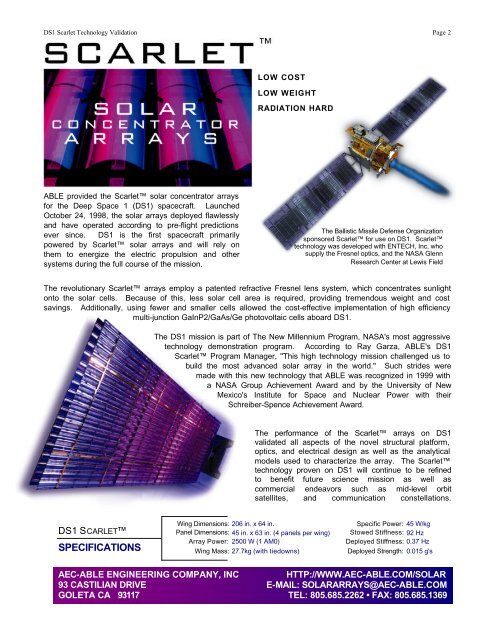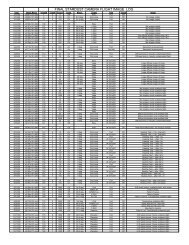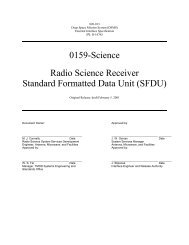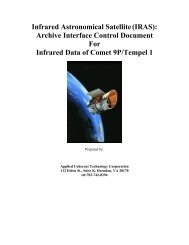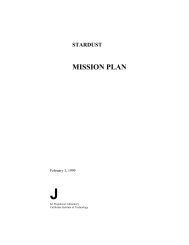The Scarlet Solar Array - PDS Small Bodies Node
The Scarlet Solar Array - PDS Small Bodies Node
The Scarlet Solar Array - PDS Small Bodies Node
- No tags were found...
Create successful ePaper yourself
Turn your PDF publications into a flip-book with our unique Google optimized e-Paper software.
DS1 <strong>Scarlet</strong> Technology Validation Page 2<br />
LOW COST<br />
LOW WEIGHT<br />
RADIATION HARD<br />
ABLE provided the <strong>Scarlet</strong> solar concentrator arrays<br />
for the Deep Space 1 (DS1) spacecraft. Launched<br />
October 24, 1998, the solar arrays deployed flawlessly<br />
and have operated according to pre-flight predictions<br />
ever since. DS1 is the first spacecraft primarily<br />
powered by <strong>Scarlet</strong> solar arrays and will rely on<br />
them to energize the electric propulsion and other<br />
systems during the full course of the mission.<br />
<strong>The</strong> Ballistic Missile Defense Organization<br />
sponsored <strong>Scarlet</strong> for use on DS1. <strong>Scarlet</strong><br />
technology was developed with ENTECH, Inc, who<br />
supply the Fresnel optics, and the NASA Glenn<br />
Research Center at Lewis Field<br />
<strong>The</strong> revolutionary <strong>Scarlet</strong> arrays employ a patented refractive Fresnel lens system, which concentrates sunlight<br />
onto the solar cells. Because of this, less solar cell area is required, providing tremendous weight and cost<br />
savings. Additionally, using fewer and smaller cells allowed the cost-effective implementation of high efficiency<br />
multi-junction GaInP2/GaAs/Ge photovoltaic cells aboard DS1.<br />
<strong>The</strong> DS1 mission is part of <strong>The</strong> New Millennium Program, NASA's most aggressive<br />
technology demonstration program. According to Ray Garza, ABLE's DS1<br />
<strong>Scarlet</strong> Program Manager, "This high technology mission challenged us to<br />
build the most advanced solar array in the world." Such strides were<br />
made with this new technology that ABLE was recognized in 1999 with<br />
a NASA Group Achievement Award and by the University of New<br />
Mexico's Institute for Space and Nuclear Power with their<br />
Schreiber-Spence Achievement Award.<br />
<strong>The</strong> performance of the <strong>Scarlet</strong> arrays on DS1<br />
validated all aspects of the novel structural platform,<br />
optics, and electrical design as well as the analytical<br />
models used to characterize the array. <strong>The</strong> <strong>Scarlet</strong><br />
technology proven on DS1 will continue to be refined<br />
to benefit future science mission as well as<br />
commercial endeavors such as mid-level orbit<br />
satellites, and communication constellations.<br />
DS1 SCARLET<br />
SPECIFICATIONS<br />
Wing Dimensions: 206 in. x 64 in.<br />
Panel Dimensions: 45 in. x 63 in. (4 panels per wing)<br />
<strong>Array</strong> Power: 2500 W (1 AM0)<br />
Wing Mass: 27.7kg (with tiedowns)<br />
Specific Power: 45 W/kg<br />
Stowed Stiffness: 92 Hz<br />
Deployed Stiffness: 0.37 Hz<br />
Deployed Strength: 0.015 g's<br />
AEC-ABLE ENGINEERING COMPANY, INC<br />
93 CASTILIAN DRIVE<br />
GOLETA CA 93117<br />
HTTP://WWW.AEC-ABLE.COM/SOLAR<br />
E-MAIL: SOLARARRAYS@AEC-ABLE.COM<br />
TEL: 805.685.2262 • FAX: 805.685.1369


